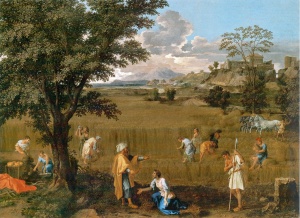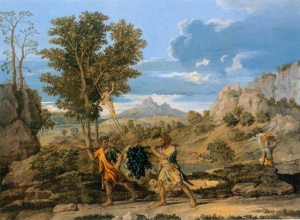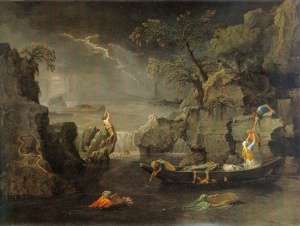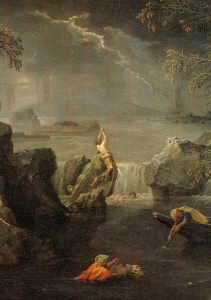Poussin’s Bible
Near the end of his long and productive life Nicolas Poussin was commissioned to paint in 1660 an unusual series of paintings called the Four Seasons. They very quickly became some of the best known and beloved of his artworks; utilizing four scenes from the Hebrew Bible to depict the Ages of Man as the seasons of the year; Adam and Eve as Spring; Boaz and Ruth as Summer; The Spies with the Grapes of the Promised Land as Autumn and finally, The Flood as Winter.
Two of these seminal works are currently on view with close to 60 other paintings and drawings in the exhibition Poussin and Nature at the Metropolitan Museum of Art. One of the questions they pose is why should this French master of the classical, i.e pagan, tradition turn to the Hebrew Bible as the definitive coda of his life’s work?
Poussin (1594-1665) is considered one of the most influential artists of the 17th century. He created a visual veneration of Classical (Greek and Roman) forms and subjects that was respected, imitated and copied for close to 200 years. Born in Normandy, France he learned the craft of painting in Paris and spent the last 40 years of his life in Rome, the physical heart of the Classical tradition and architecture. His artistic output of approximately 205 paintings is divided almost equally between Christian and Mythological/Classical History themes; with the remaining 20 percent devoted to Biblical subjects. Early masterpieces in the biblical genre include the Worship of the Golden Calf (ca.1635) and Crossing the Red Sea (ca.1635) while more mature works include Moses Striking the Rock (1649) and the Judgment of Solomon (1649) and Esther before Ahasuerus (1660). Almost all of these explicate the most dramatic and exciting aspects of the particular biblical narrative. These works are biblical narrative at its most popular; idealized, vivid, pious and cinematic. While these examples of Poussin’s biblical work surely deserve serious analysis, the late series of the Four Seasons upsets much of what we think we know about this pivotal artist.
Spring: Adam and Eve depicts the moment Eve offers the fruit of the forbidden tree to Adam. We see the primeval couple in the center of the painting surrounded by a lush garden. He sits in anticipation while Eve kneels next to him gesturing upward to the sky and to a luscious tree a few yards away laden with fruit. Behind her is another fruit-laden tree, ominously playing the role of the tree of Life. Pointedly there is no snake depicted to tempt her, only the uniquely human quality of free will. The scale of the image makes one imagine that Adam and Eve are in an enormously wild garden, embraced by nature, and quite alone. Far above this scene in the clouds is a white robed figure fleeing from the action in the foreground. This figure is none other than Poussin’s representation of God, removing Himself from the scene of the first sin.
In many of Poussin’s mature paintings the landscape takes on a pivotal role along with the textual narrative. Here the lush foliage and outcroppings are divided into three decisive groups created by the distant white peaks on the right and the negative gap in the foliage on the left. This highly structured composition locks the first man and woman into a kind of natural balance that bespeaks the very logic of creation. And yet because of mankind’s first conscious choice, emphasized by Eve’s heavenward gesture, God flees from the consequences of His creation. It would seem that from Poussin’s point of view, Creation itself is a disappointment to the Creator.

In a dramatic contrast Summer, as represented by Boaz and Ruth, presents a beacon of well reasoned hope. Here the landscape is teeming with figures all working towards a successful harvest; cutting down the fully-grown wheat, gathering and binding the harvest and providing for the constant needs of the workers. No less than 14 figures are in the fields busy with the needs of sustenance deeply associated with the season of warmth and fertility. The figures are divided into two groups; one including Boaz and the supplicant Ruth seem to represent the peaceful efforts of individuals working harmoniously together. Opposite the diagonal empty space that moves from the foreground into the middle ground, seven others can be seen as potentially aggressive figures. The worker in the foreground with the spear is admonished directly by Boaz to provide a safe environment for the stranger Ruth. Deeper into the field five horses are being whipped as they are threshing the harvested wheat. Amidst three male workers a woman looks back at the viewer with considerable concern as to her safety. The dynamic and complex relationship between man and woman and nature could not be more dramatically expressed.
In Summer the hope for a successful relationship between the Jewish people and the natural world so necessary to build a fruitful future is ardently expressed. The red cloak spread out on the ground along the left side could easily allude to the cloak that Boaz eventually spreads over Ruth in the act that symbolizes their future marriage that leads to the progenitor of King David.

That hope is effectively dashed in the painting of Autumn, the fateful setting for the Spies with the Grapes from the Promised Land. Here the figures can be said to dominate the land, the two spies forcefully stride across the foreground while a woman peacefully makes her way towards the stream where we can glimpse a man fishing. All is deceptively serene as a woman is seen perched high on a ladder harvesting fruit directly behind the spies; ironically harvesting the faithlessness of the spies’ fears of the terrors of the unknown land of Israel and Jewish destiny. This woman is plucking fruit from a tree uncomfortably similar to the forbidden tree in the Garden of Eden seen in the first painting. Here the landscape is rocky and a bit wild, with a town seen in the distance perched above formidable cliffs in subtle contrast to the more bucolic and civilized landscape of the fields of Boaz.
What these late paintings show is that Poussin was a uniquely unusual artist not only in his abundance of skill but also in his independence of mind and subject matter. He intimates great swaths of biblical narrative and commentary with remarkable economy. Unlike much of his earlier work; mythological, Christian and biblical included, Poussin’s late works open up personal insights and meanings of these biblical texts without bombast and didactic stridency. This is especially poignant for this 70 year old artist whose sobering view of human history reaches its climax in the last painting of the series and possibly one of the very last he painted.


Winter (The Flood) presents a deeply pessimistic view of the tragedy of human fate. While earlier artists, most notably Michelangelo on the Sistine Chapel, have seen the destruction of the entire world in the time of Noah as tragic, nevertheless the struggles of mankind to survive are depicted as heroic and positive. Poussin has no such consolation for us in this painting. Each and every effort of his figures is immediately seen as hopeless and futile. The man in the foreground grasping the horns of a terrified animal knows there is no safe shore for the beast to emerge. Similarly the woman trying to stay afloat with a rectangle of wood is doomed as the wood becomes waterlogged and sinks. Every effort to utilize the boat resting near the craggy rocks is hopeless; a man desperately attempts to climb the slippery side, another fruitlessly attempts to push off even as a woman reaches up with her child to save it, just out of reach from the man above. Even the man trapped in the boat about to be swamped at the falls prays to a heaven that we know will ignore him. The only answer is a flash of lightning that portends even more rain. Every figure in this painting is seen literally reaching for something that is clearly unattainable.
It would seem that a lifetime overwhelmingly devoted to the exploration and revival of the Classical world could not yield sustenance to face the next. Nonetheless the complexity and depth of the biblical in this unusual narrative form (the Four Seasons) could at least yield an adequate expression of a grand master’s despair in his final years.